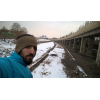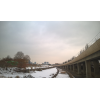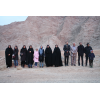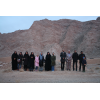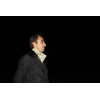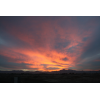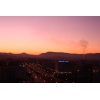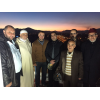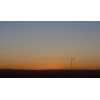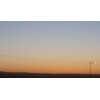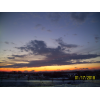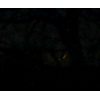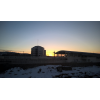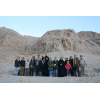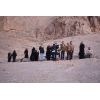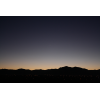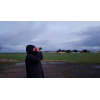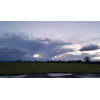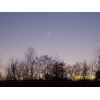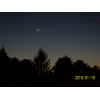Visibility of Jumadal Al-Aula Crescent 1439 AH
- When to Observe Jumadal Al-Aula Waxing (NEW) Crescent ?
- Jumadal Al-Aula Waxing (NEW) Crescent Observation Results
- The OFFICIAL First Day in Different Countries
- When to Observe Rabee' Al-Aakher Waning (OLD) Crescent ?
- Rabee' Al-Aakher Waning (OLD) Crescent Observation Results
When to Observe Jumadal Al-Aula Waxing (NEW) Crescent ?
The geocentric conjunction (Geocentric New Moon) will occur Inshalla on (Wedensday 17 January 2018) at 02:17 UT.
Sighting the new crescent on (Wedensday 17 January 2018) and (Thursday 18 January 2018) is shown in the below graphs using the program Accurate Times by Mohammad Odeh according to Odeh criterion. Where:-
- It is impossible to see the crescent from the areas located under the red color. Because either the Moon on this day sets before the Sunset and/or the topocentric conjunction occurs after the Sunset.
- The crescent is expected to be seen by optical aid only from the areas located under the blue color.
- The crescent is expected to be seen by optical aid from the areas located under the magenta color. In these areas the crescent could be seen by naked eye if the atmospheric conditions are superb and the observer is experienced.
- The crescent is expected to be easily visible by naked eye from the areas located under the green color.
- The crescent cannot be seen from uncolored areas, even though the Moon sets in these locations after the Sunset and the topocentric conjunction occurs before the Sunset, but the Moon is not sufficiently illuminated in order to be seen as crescent even by optical aid.
- Kindly notice that the below graph shows the possibility of seeing the crescent from areas between 60 degrees north of Equator down to 60 degrees south of Equator.
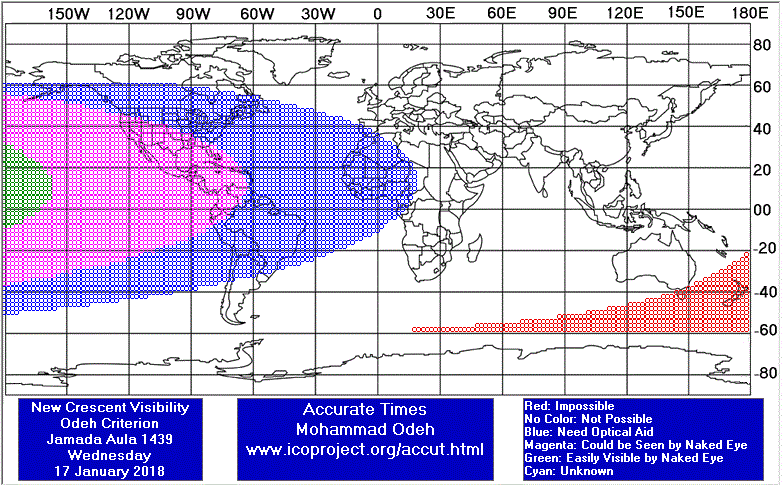

According to the Universal Hejric Calendar (UHC), which is based on the calculated crescent visibility, the start of this month in the Eastern Region will be on Thursday 18 January 2018 and in the Western Region will be on Thursday 18 January 2018. Kindly notice that the UHC is a pre-calculated calendar, which adopts a certain criterion to start the new Hejric month. Your country/organization might adopt different criterion to start the new Hejric month. So it is highly advised to read the UHC website before giving any judgment.
- Results of seeing the crescent, and the first day of the month in different countries will be added here Inshalla as we receive the reports from ICOP's members. If you wish to be a member in ICOP, or to know more about it, kindly click here.
Jumadal Al-Aula Waxing (NEW) Crescent Observation Results
Wed 17 January 2018
Australia
Indonesia
Mr. AR Sugeng Riyadi said: "The new crescent of Jumadal Ula 1439 AH was not seen on Wednesday, 17 January 2018 from Assalaam Observatory at PPMI Assalaam Sukoharjo by my students of CASA and neither at Rowasiya Observatory, Bendo Ketitang Juwiring Klaten Central Java Indonesia. The sky was totally cloudy and rainy."
Iran
Mr. Hossein Janghorbani said: "Mr.Reza Janghorbani based in the city of Tabriz in East Azerbaijan province due to cloudy weather, Not see the crescent moon."
Mr. Hossein Janghorbani said: "In the name of God Jumadal Al-Aula Crescent Observation Report The Astronomy and Geophysics Center of Shahreza – The Crescent Association of Shahreza Report by: Hossein Janghorbani (Najmosepehr-Sadrolmonajjemin) – Manager of Shahreza Crescent Association and Red Crescent’s Astronomy and Geophysics Center Date: Wedensday, 01/17/2018 Location: Damzad foothills in the East of Shahreza (latitude: 32 00 N, longitude: 51 52 E, elevation: 1825m from sea level, time zone: +3.5 GMT) Equipments: Two sets of 15*70 binoculars, One sets of 20*90 binoculars, One sets of 25*100 binoculars, One compass. Atmospheric condition: cloudy. Horizon obstacles: 2.5° Apparent sunset: ..:.. Results: Moon crescent was not seen by naked eye, Moon crescent was not seen by binocular. Observers: 1.Mohammad Reza Kazemi 2.Mohammad Javad Nikeghbal 3.Mohammad Sadra Nikeghbal 4. Saer Aliabedi 5.Ali Janghorbani 6. Hossein Janghorbani 7.Fatemeh Torabi 8.Ezat Nazariat 9. .Parisa Ghadimi 10.Shahideh Torabi 11.Toktam Aliabedi 12.Ziba Hafar 13.Zinat Ghermezi 14.Masoomeh Ahmadi 15.Zahra Fallahi "
Morocco
Mr. Abdessamad Doukkane said: "راقبت جمعية المبادرة المغربية للعلوم والفكر هلال جمادى الأولى 1439 هـ مع مندوبية الأوقاف والشؤون الإسلامية مساء يوم الاربعاء بصومعة المسجد الكبير بالناظور. ولم تثبت رؤيته بالتاظور والجهة الشرقية."
Oman
Prof. Mohammed Al-Bussaidi said: "The weather was clear but hazy. The Crescent was not seen."
South Africa
United States
Dr. Javad Torabinejad said: "I arrived late at my sighting location at 5:52 pm EST (sunset: 5:30 pm). Using a pair of binoculars (7X50), I scanned a partly cloudy and hazy west southwestern horizon with no success. I ended the session at 6:10 pm (moonset: 6:13 pm)."
Thu 18 January 2018
Algeria
Hungary
Indonesia
Mr. AR Sugeng Riyadi said: "The new crescent of Jumadal Ula 1439 AH was not seen on Thursday, 18 January 2018 from Assalaam Observatory at PPMI Assalaam Sukoharjo by my students of CASA and neither at Rowasiya Observatory, Bendo Ketitang Juwiring Klaten Central Java Indonesia. The sky was rainy."
Iran
Mr. Hossein Janghorbani said: "Mr.Reza Janghorbani based in the city of Tabriz in East Azerbaijan province Moon Crescent At 17:38 is observed with the 15*70 binoculars and Moon Crescent At 17:42 is observed with the naked eye."
Mr. Hossein Janghorbani said: "In the name of God Jumadal Al-Aula Crescent Observation Report The Astronomy and Geophysics Center of Shahreza – The Crescent Association of Shahreza Report by: Hossein Janghorbani (Najmosepehr-Sadrolmonajjemin) – Manager of Shahreza Crescent Association and Red Crescent’s Astronomy and Geophysics Center Date: Thursday, 01/18/2018 Location: Damzad foothills in the East of Shahreza (latitude: 32 00 N, longitude: 51 52 E, elevation: 1825m from sea level, time zone: +3.5 GMT) Equipments: Two sets of 15*70 binoculars, One sets of 20*60 binoculars, One sets of 7*50 binoculars, One compass. Atmospheric condition: hazy. Horizon obstacles: 2.5° Apparent sunset: 17:13 Results: Moon crescent was seen by 15*70 binoculars by Hossein Janghorbani at 17:24, for the first time. Other group members observed crescent by binoculars subsequently. Crescent observed by Zahra Fallahi at 17:26 by naked eye. Other group members observed crescent by naked eye. Observers: 1.Sayed Mohammad javad Eezadi 2.Sayed Hossein Madani 3.Mohammad Reza Dadfar 4.Alireza Baghernia 5.Shantia Shahsavar 6.Abdolreza Gholami 7.Mahdi Ghasemi 8.MohammadSadra Nikeghbal 9.MohammadJavad Nikeghbal 10.Amir Salimpoor 11.Ali Janghorbani 12.Hossein Janghorbani 13.Hasti Salimpoor 14.Tabasom Yaghoobi 15.Arezoo Baghernia 16.Parisa Ghadimi 17.Ezat Nazariat 18.Ziba Hafar 19.Fatemeh Tavakoli 20.Zinat Ghermezi 21.Roya Ghermezi 22.Zahra Fallahi "
United Kingdom
Eng. Qamar Uddin said: "At about 4.59 pm I and one of the others were able to see the crescent moon very clearly with binoculars between a patch of clouds. We hurried to position our camera to take photo of the crescent moon (Hilal) but it was covered very quickly by another bank of clouds within a couple of minutes. See more detailed report on ICOUK.net"
United States
Dr. Javad Torabinejad said: "I arrived at my sighting location (the Blacksburg High School) at 5:29 pm EST (sunset: 5:31 pm). Using a pair of binoculars, I looked for the crescent in a clear west southwest horizon. My first binocular sighting was at 5:32 pm and shortly after followed by a naked eye sighting at 5:33 pm. The crescent was easy to see with its horns at 2:45 and 7:30 O'clock (2:45;5:00;7:30). After changing my locations a couple of times to capture a few images, at 6:18 pm, I left for home (moonset: 7:09 pm)."
Dr. Javad Torabinejad said: "At 2:34 pm EST, using a pair of binoculars, I was able to see the crescent. Sunset was at 5:31 pm. The crescent's horns were at 2:30 and 5:30 O'clock (2:30;4:00;5:30). For a short period, I tried sighting it with naked eye with no success."
The OFFICIAL First Day in Different Countries
Thu 18 January 2018
1 . Bahrain
2 . Egypt
3 . Indonesia
4 . Jordan
5 . Kuwait
6 . Qatar
7 . Saudi Arabia
8 . United Arab Emirates
Fri 19 January 2018
1 . Australia
2 . Iran
3 . Morocco
4 . Oman
5 . South Africa
6 . United Kingdom
When to Observe Rabee' Al-Aakher Waning (OLD) Crescent ?
The geocentric conjunction (Geocentric New Moon) will occur Inshalla on (Wedensday 17 January 2018) at 02:17 UT.
Sighting the OLD crescent on (Wedensday 17 January 2018) and (Tuesday 16 January 2018) is shown in the below graphs using the program Accurate Times by Mohammad Odeh according to Odeh criterion. Where:-
- It is impossible to see the OLD crescent from the areas located under the red color. Because either the Moon on this day rises after the Sunrise and/or the topocentric conjunction occurs before the Sunrise.
- The crescent is expected to be seen by optical aid only from the areas located under the blue color.
- The crescent is expected to be seen by optical aid from the areas located under the magenta color. In these areas the crescent could be seen by naked eye if the atmospheric conditions are superb and the observer is experienced.
- The crescent is expected to be easily visible by naked eye from the areas located under the green color.
- The crescent cannot be seen from uncolored areas, even though the Moon rises in these locations before the Sunrise and the topocentric conjunction occurs after the Sunrise, but the Moon is not sufficiently illuminated in order to be seen as crescent even by optical aid.
- Kindly notice that the below graph shows the possibility of seeing the crescent from areas between 60 degrees north of Equator down to 60 degrees south of Equator.
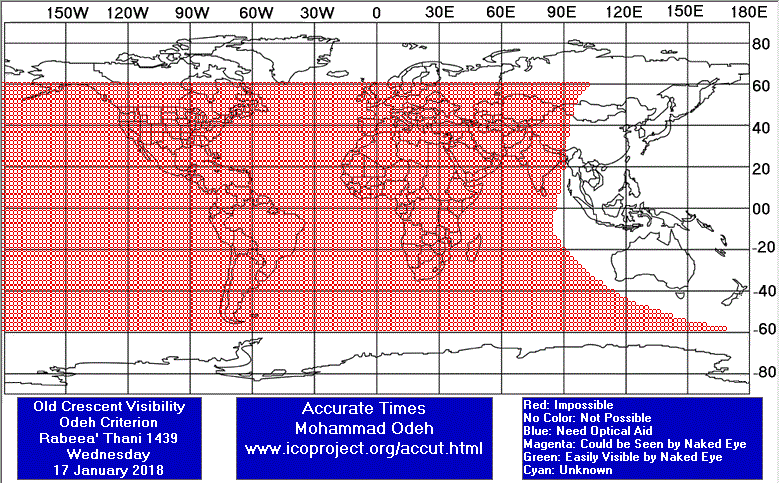
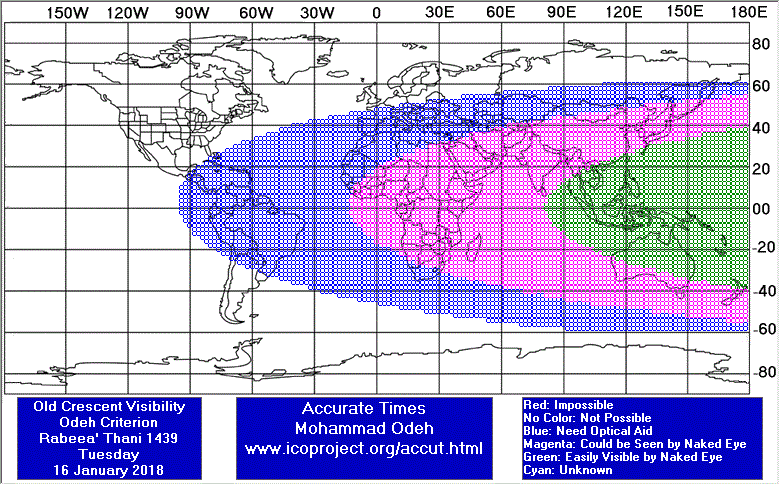
Rabee' Al-Aakher Waning (OLD) Crescent Observation Results
Tue 16 January 2018
Indonesia
Mr. AR Sugeng Riyadi said: "The old crescent of Rabiul Akhir 1439 AH was not seen on Tuesday, 16 January 2018 from Rowasiya Observatory, Bendo Ketitang Juwiring Klaten Central Java Indonesia. The sky was totally cloudy."
Wed 17 January 2018
Indonesia
Mr. AR Sugeng Riyadi said: "The old crescent of Rabiul Akhir 1439 AH was not seen on Wednesday, 17 January 2018 from Rowasiya Observatory, Bendo Ketitang Juwiring Klaten Central Java Indonesia. The sky was hazy..."
